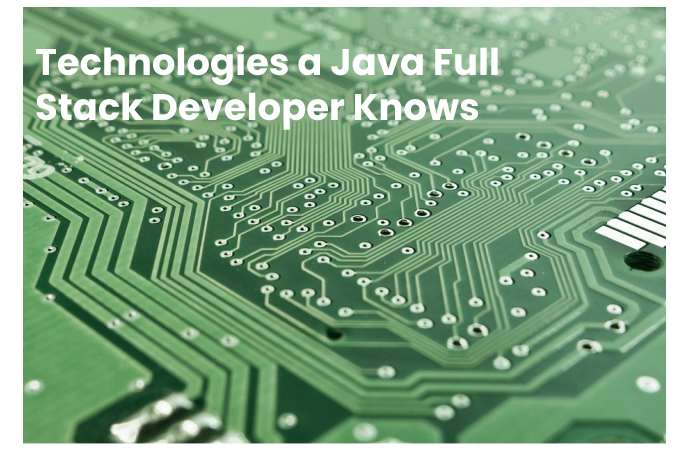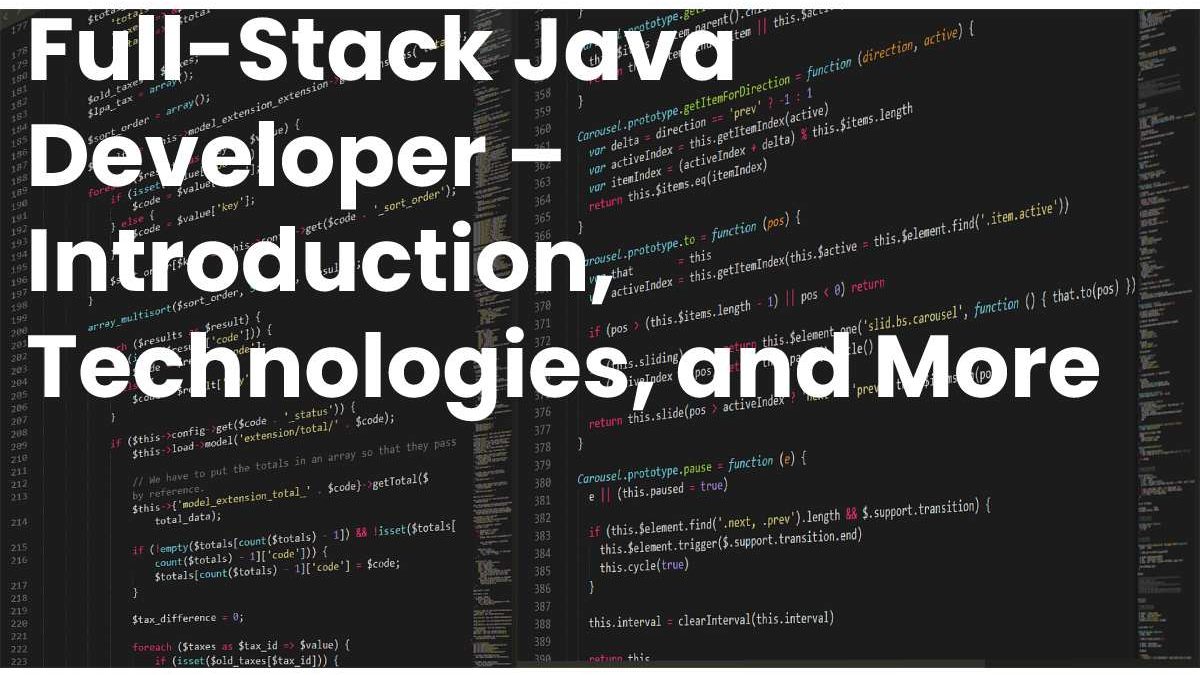Table of Contents
What is a Full Stack Developer?
Full-Stack Java Developer – This type of creator works on the entire stack of a software application, i.e. front-end development, back-end development, database, server, API, and version control systems. Hence the name “Full Stack” Developer.
Therefore, the full stack developer translates user needs into the overall architecture and implements new systems. A Full-Stack Developer does not necessarily master all the technologies. However, the professional expects to make an effort on the client-side and the server-side and understand what is happening while developing an application. Thus, they must have a genuine interest in all software technologies.
Why do you need a Full-Stack Developer?
Here are some important reasons why you should hire a full-stack development professional:
- A full-stack developer helps you keep every part of the system running smoothly
- The full-stack developer can support all team members and significantly reduce team
- communication time and technical costs. If one person performs different roles, it saves your company’s personnel, infrastructure and operational costs
What is a Java Full Stack Developer?
Nowadays, becoming a web developer has not been so easy. First, you have to master a whole stack or set of technologies. And this set is called Full-stack.
Therefore, with the rapid adoption of mobile phones, users accessing web applications from their mobile phones has increased dramatically. Therefore, there was a demand for technologies capable of creating a web application that works efficiently on desktop computers and mobile phones. Besides that, the user interface would also be beautiful and easy to use on portable headphones.
It includes HTML5, Bootstrap, Angular JS, etc. The most important feature of these responsive web apps is that the user interface changes automatically according to the size of the mobile device.
Therefore, With the arrival of new technologies, the expectations of web developers were also increasing. This stack starts in HTML and reaches the central database. Here, recruiters expect a full-stack developer to know all the technologies so that they can quickly develop an application. Perhaps with one hand.
Technologies a Java Full Stack Developer Knows

Full-stack technologies can categorize into several sections: client-side scripts, server-side scripts, and back-end databases.
Client-Side Technologies
Thus, this include HTML5, CSS3, JavaScript, jQuery, Bootstrap, Angular JS/React JS.
Server-Side Technology
Therefore, some technologies used here are advanced forms of older skills. They comprise Servlet/JSP, ASP.NET MVC, PHP, etc. Some of the prevalent frameworks used in the industry today are Hibernate and Java Spring, Spring Boot, and Node.js.
Database Technologies
Therefore, the files used in the backend can be RDBMS or SQL databases, and the rest are non-SQL databases. Instances of RDBMS are Oracle, SQL Server, MySQL, and Postgres. Recently, next-generation databases called non-SQL databases have become popular. Examples of these are MongoDB, CouchDB, etc.
Lamp Versus Media
Therefore, PHP web developers are familiar with the acronym Lamp. However, with the period of responsive Web and full-stack development, the new stack that is becoming popular is MEAN, which builds on an influential JavaScript engine.
Technology Related to Full-Stack Java Developer:
Interface: is the visible part of the website or web application responsible for the user experience. The user interrelates directly with the front end of the web application or website.
Interface Languages – The interface part creates using some languages which describe under:
- HTML: HTML is known as Hypertext Markup Language. It uses a markup language to project the front end of web pages. HTML is a mixture of hypertext and markup language. Hypertext describes the link between web pages. The markup language uses to explain the text documentation within the tag that defines the structure of web pages.
- CSS: Cascading Style Sheets, affectionately referred to as CSS, is a simple layout language intended to simplify the procedure of making web pages presentable. CSS lets you apply styles to web pages.
- In addition, CSS allows you to do this independently of the HTML for each web page.
- JavaScript: JavaScript is a famous scripting language used to create the magic in the sites to make the site interactive for the user. It uses to enhance the functionality of a website to run cool games and web-based software.
Full-Stack Java Developer Frontend libraries and Frameworks:
AngularJS – Angular is an open-source JavaScript frontend framework primarily used for developing Single Page Web Applications (SPAs). It is a continually growing and expanding framework that provides better ways to develop web applications. Change static HTML to dynamic HTML. It is an open-source project that anyone can freely use and change. It extends HTML attributes with Directives and the data-bound with HTML.
React.js – React is a declarative, efficient, and flexible JavaScript library for building user interfaces. ReactJS is an open-source component-based frontend library responsible only for the application’s display layer. It maintains by Facebook.
Bootstrap – Bootstrap is a collection of free and open-source tools for building responsive sites and web applications. It is the most significant popular HTML, CSS, and JavaScript framework for emerging responsive and mobile websites.
jQuery – jQuery is an open-source JavaScript library that simplifies interactions between an HTML/CSS document, the Document Object Model (DOM), and JavaScript. By elaborating on the terms, jQuery simplifies traversing and manipulating HTML documents and handling browser events.
Full-Stack Java Developer Other Ideas:
Make the UI accountable using the web system.
Git and git orders like infit, add, commit, etc., for various control and work with the team.
Other tools like npm and Yarn package managers, sass CSS preprocessor, browser dev tools, i.e. chrome dev tools.
Understand HTTP, JSON, and Graph API to get data using Axis or other devices.
It also needs some design skills to make the design look the best.
Back-end: Refers to the server-side development of a web application or website with a prime focus on how the site works. It is responsible for managing the database over enquiries and APIs using client-side commands. Thus, this type of website mainly contains three parts: frontend, backend, and database.
Therefore, the back-end part creates by using some libraries, frameworks and languages, which discusses below:
PHP: PHP is a server-side programming language explicitly designed for web development. Since the PHP code executes on the server-side, it is called a server-side scripting language.
C++ is a general-purpose programming language widely used today for competitive program design. Therefore, It operates as a backend language.
Java:
Java is one of the most incredible popular and widely used programming languages and platforms. It is highly scalable. Java components are readily available.
Python:
Python is a programming language that lets you work quickly and integrate systems more efficiently.
JavaScript:
JavaScript can use as a programming language (front-end and back-end).
Node.js –
Node.js is an open-source, cross-platform runtime environment for running JavaScript code outside of a browser. It would be best to remember that NodeJS is not a framework, and it is not a programming language. Therefore, Most individuals are confused and understand that it is a framework or a speech. We often use Node.js to create back-end services as APIs like a web app or mobile app.
Therefore, Back-end structures: the list of back-end lines: Express, Django, Rails, Laravel, Spring, etc.
The other back-end scripting/programming languages are: C#, Ruby, REST, GO, etc.
Other Important Points:
Therefore, structure data efficiently.
Handle API request-response to store and retrieve data.
Firstly, Data security is essential.
Note: JavaScript is essential to all stacks, as it is the dominant technology on the Web.
Database: A database is the collection of interrelated data that helps in the efficient retrieval, insertion and deletion of data from the database and classifies the data in tables, views, schemas, reports, etc.
Oracle: Oracle database is the collection of information treated as a unit. This database aims to store and regain information related to the query. It is a database server and is used to manage data.
Therefore, MongoDB – MongoDB, the most popular NoSQL database, is an open-source, document-oriented database.
Popular Stacks:
- Pila MEAN: MongoDB, Express, AngularJS, y Node.js.
- Pila MERN: MongoDB, Express, ReactJS y Node.js
- Django stack: Django, Python, and MySQL as the database.
- Rails o Ruby on Rails: utilize Ruby, PHP, y MySQL.
- Pila LAMP: Linux, Apache, MySQL, y PHP.
Full-Stack Java Developer Conclusion
The term full-stack developer is somewhat controversial in the tech community, while many argue the existence of such terminology is disputed by many. Full-stack if it comes from English for “full-stack” or rather “all layers”, then first we have to understand that this term has been adapting its meaning.
When I started working with technology over ten years ago, many used this definition for people who understood all the layers of web development, including frontend, backend, and infrastructure/database. So when someone refers to the entire stack, they are probably referring to a developer who acts on both layers: Frontend and Backend.
Read Also: Thunderpick Bitcoin – Introduction, License and Regulation


